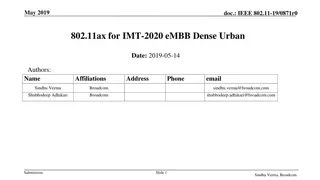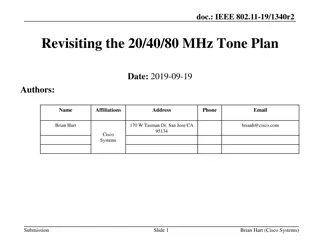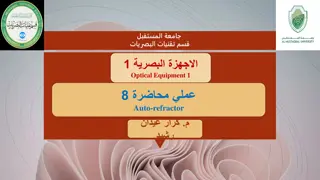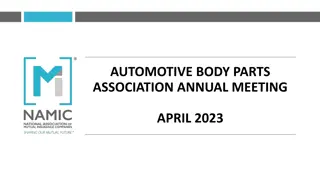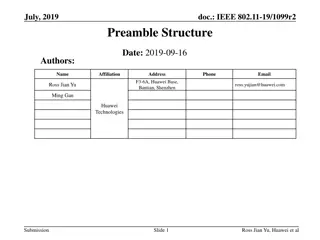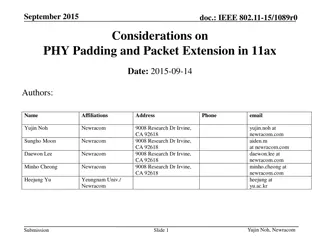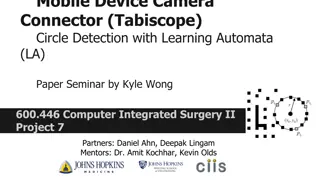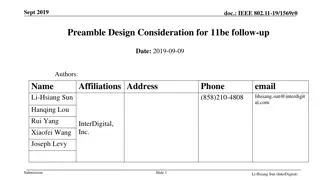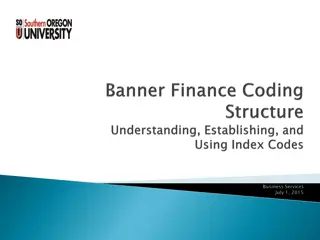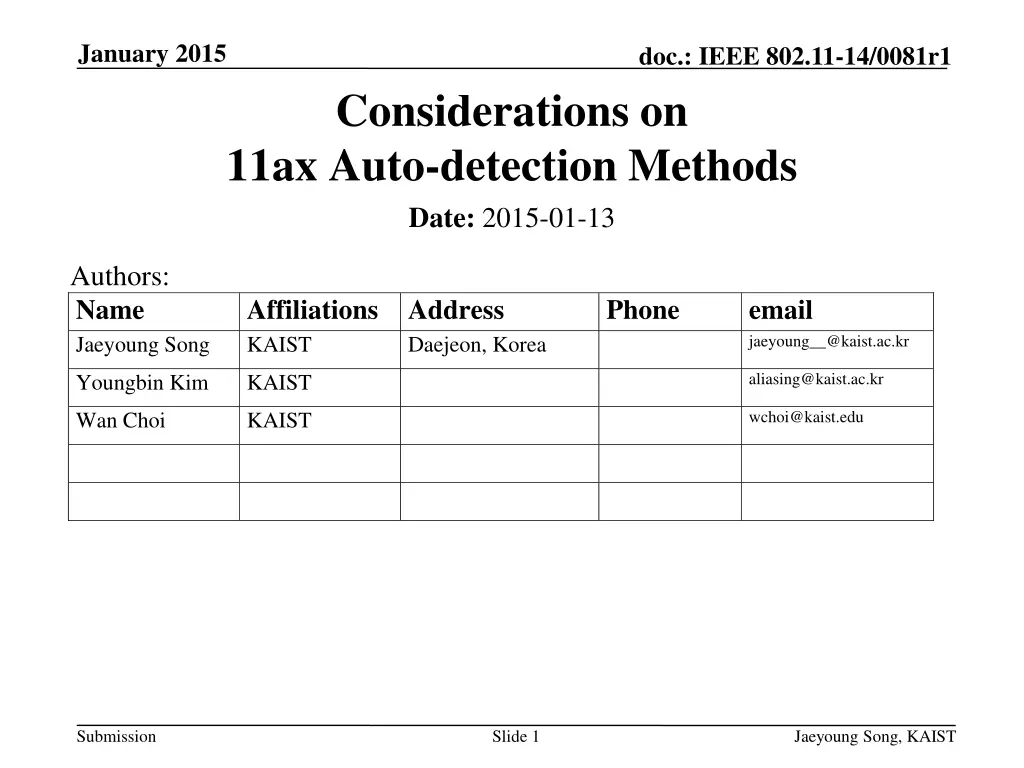
Understanding Auto-detection Methods in IEEE 802.11ax
Explore considerations and methods for auto-detection in IEEE 802.11ax networks to ensure backward compatibility and coexistence with legacy devices. The discussion covers modulation schemes, symbol durations, and implications on HE-SIG design between legacy and 11ax devices.
Uploaded on | 0 Views
Download Presentation

Please find below an Image/Link to download the presentation.
The content on the website is provided AS IS for your information and personal use only. It may not be sold, licensed, or shared on other websites without obtaining consent from the author. If you encounter any issues during the download, it is possible that the publisher has removed the file from their server.
You are allowed to download the files provided on this website for personal or commercial use, subject to the condition that they are used lawfully. All files are the property of their respective owners.
The content on the website is provided AS IS for your information and personal use only. It may not be sold, licensed, or shared on other websites without obtaining consent from the author.
E N D
Presentation Transcript
January 2015 doc.: IEEE 802.11-14/0081r1 Considerations on 11ax Auto-detection Methods Date: 2015-01-13 Authors: Name Jaeyoung Song Affiliations Address KAIST Phone email jaeyoung__@kaist.ac.kr Daejeon, Korea aliasing@kaist.ac.kr Youngbin Kim KAIST wchoi@kaist.edu Wan Choi KAIST Submission Slide 1 Jaeyoung Song, KAIST
January 2015 doc.: IEEE 802.11-14/0081r1 Background (1/2) One of the major requirements of 11ax is backward compatibility and coexistence with legacy IEEE 802.11 devices operating in the same band [1]. Legacy IEEE 802.11 devices have their auto-detection scheme. To keep coexistence with legacy IEEE 802.11 devices, it is important to investigate methods for auto-detection in 11ax In this contribution, some considerations on 11ax auto- detection are addressed. Submission Slide 2 Jaeyoung Song, KAIST
January 2015 doc.: IEEE 802.11-14/0081r1 Background(2/2) Recap: 11n/11ac Auto-detection Using different modulation on symbols of HT/VHT-SIG field 1st symbol 2nd symbol 2nd symbol 1st symbol HT-SIG VHT-SIG HT-STF HT-LTF HT-Data L-STF L-LTF L-SIG HT-SIG 11n Modulation specified in HT-SIG QPSK QPSK BPSK BPSK BPSK QBPSK QBPSK QPSK QPSK BPSK BPSK BPSK VHT-STF VHT-LTF VHT-Data L-STF L-LTF L-SIG VHT-SIG 11ac Modulation specified in VHT-SIG BPSK QBPSK QPSK QPSK BPSK BPSK BPSK QPSK QPSK BPSK BPSK BPSK Submission Slide 3 Jaeyoung Song, KAIST
January 2015 doc.: IEEE 802.11-14/0081r1 Auto-detection in Legacy and 11ax 256 FFT OFDM is proposed in [2] and [3]. 256 FFT OFDM symbol has different symbol duration with 64 FFT OFDM symbol Legacy devices operate auto-detection with part of 256 FFT symbol Number of symbols used for HE-SIG design is important for auto-detection between legacy and 11ax Depending on number of symbol used for auto-detection, impact on HE-SIG overhead and legacy auto-detection performance can be significant. Submission Slide 4 Jaeyoung Song, KAIST
January 2015 256 FFT OFDM for 11ax HE-SIG Symbols - Legacy vs. 11ax doc.: IEEE 802.11-14/0081r1 HT/VHT-STF HT/VHT-LTF Data L-STF L-LTF L-SIG HT/VHT-SIG 11n/11ac Modulation specified in HT/VHT-SIG QBPSK/ BPSK QBPSK/ QBPSK QPSK QPSK BPSK BPSK BPSK QPSK QPSK BPSK BPSK BPSK 4 s Data HE-STF and HE-LTF L-STF L-LTF L-SIG HE-SIG 11ax Modulation specified in HE-SIG QPSK QPSK BPSK BPSK BPSK TBD TBD 13.6 s 256 FFT OFDM symbol has 4 times longer symbol. Legacy devices will run auto-detection with front part of 256 FFT OFDM symbol. 64 FFT on front part of symbol with 256 IFFT will generate unexpected energy distribution Submission Slide 5 Jaeyoung Song, KAIST
January 2015 doc.: IEEE 802.11-14/0081r1 256 FFT OFDM for 11ax HE-SIG Symbols - 11n vs 11ax 1x1, Channel model D NLOS, 20 MHz BW Severe false detection rate is expected for legacy devices Submission Slide 6 Jaeyoung Song, KAIST
January 2015 doc.: IEEE 802.11-14/0081r1 64 FFT OFDM for 11ax HE-SIG Symbols - Number of HE-SIG Symbols For coexistence with legacy devices, 64 FFT size is expected for HE-SIG. Depending on the number of symbols on HE-SIG, 11ax auto-detection methods can be considered as follows: Scheme 1: Three symbols are used for 11ax auto-detection Scheme 2 or 3: Two symbols are used for 11ax auto-detection Submission Slide 7 Jaeyoung Song, KAIST
January 2015 doc.: IEEE 802.11-14/0081r1 64 FFT OFDM for 11ax HE-SIG Symbols - Scheme 1: 3-symbol Structure HT/VHT-STF HT/VHT-LTF Data L-STF L-LTF L-SIG HT/VHT-SIG 11n/11ac Modulation specified in HT/VHT-SIG QBPSK/ BPSK QBPSK/ QBPSK QPSK QPSK BPSK BPSK BPSK QPSK QPSK BPSK BPSK BPSK 4 s HE-STF and HE-LTF Data L-STF L-LTF L-SIG HE-SIG Scheme 1 Modulation specified in HE-SIG QPSK QPSK BPSK BPSK BPSK TBD BPSK BPSK QBPSK ... TBD 4 s HE-SIG Scheme 1 BPSK on 1st symbol BPSK on 2nd symbol QBPSK on 3rd symbol 3rd symbol 2nd symbol 1st symbol Submission Slide 8 Jaeyoung Song, KAIST
January 2015 doc.: IEEE 802.11-14/0081r1 64 FFT OFDM for 11ax HE-SIG Symbols - Scheme 1: Miss Detection Scheme 1 (BPSK BPSK QBPSK) distinguishes 11n,11ac, and 11a/g data packet with 1st symbol, 2nd symbol and 3rd symbol of HE-SIG, respectively. Scheme 1 completes auto- detection one symbol duration later than 11n/11ac auto-detection does More overhead is needed to buffer at least three symbols Submission Slide 9 Jaeyoung Song, KAIST
January 2015 doc.: IEEE 802.11-14/0081r1 64 FFT OFDM for 11ax HE-SIG Symbols - Scheme 1: False Detection (11ax 11n/ac) Similar false detection rate with 11n and 11ac auto-detection Submission Slide 10 Jaeyoung Song, KAIST
January 2015 doc.: IEEE 802.11-14/0081r1 64 FFT OFDM for 11ax HE-SIG Symbols - Scheme 2 or 3: 2-symbol Structure 11ax auto-detection scheme similar with 11n/11ac auto-detection can determine the packet in the same timeline of 11n/11ac. HT/VHT-STF HT/VHT-LTF Data L-STF L-LTF L-SIG HT/VHT-SIG 11n/11ac Modulation specified in HT/VHT-SIG QBPSK/ BPSK QBPSK/ QBPSK QPSK QPSK BPSK BPSK BPSK QPSK QPSK BPSK BPSK BPSK 4 s HE-STF and HE-LTF Data L-STF L-LTF L-SIG HE-SIG Scheme 2 Modulation specified in HE-SIG QBPSK BPSK ... TBD TBD QPSK QPSK BPSK BPSK BPSK 4 s Data HE-STF and HE-LTF L-STF L-LTF L-SIG HE-SIG Scheme 3 Modulation specified in HE-SIG ... TBD BPSK BPSK QPSK QPSK BPSK BPSK BPSK TBD 4 s Submission Slide 11 Jaeyoung Song, KAIST
January 2015 doc.: IEEE 802.11-14/0081r1 64 FFT OFDM for 11ax HE-SIG Symbols - Scheme 2 or 3: 2-symbol Structure 11ax auto-detection scheme similar with 11n/11ac auto-detection can determine the packet in the same timeline of 11n/11ac. Scheme 2 : 1st symbol 2nd symbol Scheme 3: 1st symbol 2nd symbol Submission Slide 12 Jaeyoung Song, KAIST
January 2015 doc.: IEEE 802.11-14/0081r1 64 FFT OFDM for 11ax HE-SIG Symbols - Scheme 2: QBPSK BPSK Some 11n devices operate auto- detection using only on 1st symbol of HT-SIG [4]. Severe false detection is expected for those 11n devices. Submission Slide 13 Jaeyoung Song, KAIST
January 2015 doc.: IEEE 802.11-14/0081r1 64 FFT OFDM for 11ax HE-SIG Symbols - Scheme 3: BPSK BPSK Additional detection is needed for classification between 11a/g and 11ax packets Scheme 3 can distinguish 11n/11ac packets but has the same modulation if data field of 11a/g packet is modulated as BPSK. 1. CRC check of HE-SIG can distinguish 11a/g packet 2. Property of symbols following HE-SIG such as HE-STF or HE-LTF can be used to distinguish 11a/g packet Submission Slide 14 Jaeyoung Song, KAIST
January 2015 doc.: IEEE 802.11-14/0081r1 Reusing 11ac auto-detection in 2.4 GHz According to IEEE 802.11ac [5], The IEEE 802.11 VHT STA operates in frequency bands below 6 GHz excluding the 2.4 GHz band. Completion of auto-detection between legacy and 11ax may be delayed due to overhead increase or additional decoding for 11ax. Providing the reuse of 11ac auto- detection scheme in 2.4 GHz may be beneficial for 11ax . 1st symbol 2nd symbol First two symbols of HE-SIG in 2.4 GHz Submission Slide 15 Jaeyoung Song, KAIST
January 2015 doc.: IEEE 802.11-14/0081r1 Summary Modulation schemes for HE-SIG symbol FFT size on HE-SIG Number of symbols on HE-SIG Comments 1st SYM 2nd SYM 3rd SYM 4-time longer HE-SIG symbol degrades legacy auto-detection performance 256 - BPSK - - Increased overhead with additional SIG symbol 3 or more BPSK BPSK QBPSK Critical false detection occurs to 11n devices Additional detection is needed to distinguish b/w 11a/g packet and 11ax 64 2 QBPSK BPSK 2 BPSK BPSK For 11ax preamble design, we need to take those considerations into account to keep backward compatibility and coexsistence Submission Slide 16 Jaeyoung Song, KAIST
January 2015 doc.: IEEE 802.11-14/0081r1 References [1] Lei Wang, Proposed 802.11ax functional requirement, 11-14/1009r2, Sep. 2014. [2] Jinsoo Choi, Envisioning 11ax PHY Structure - Part I, 11-14/0804r1, July 2014. [3] Dongguk Lim, Envisioning 11ax PHY Structure - Part II, 11-14/0801r0, July 2014. [4] Yung-Szu Tu, Proposed TGac Preamble, 11-10/0130r0, Jan. 2010. [5] IEEE Std 802.11ac -2013 Submission Slide 17 Jaeyoung Song, KAIST




